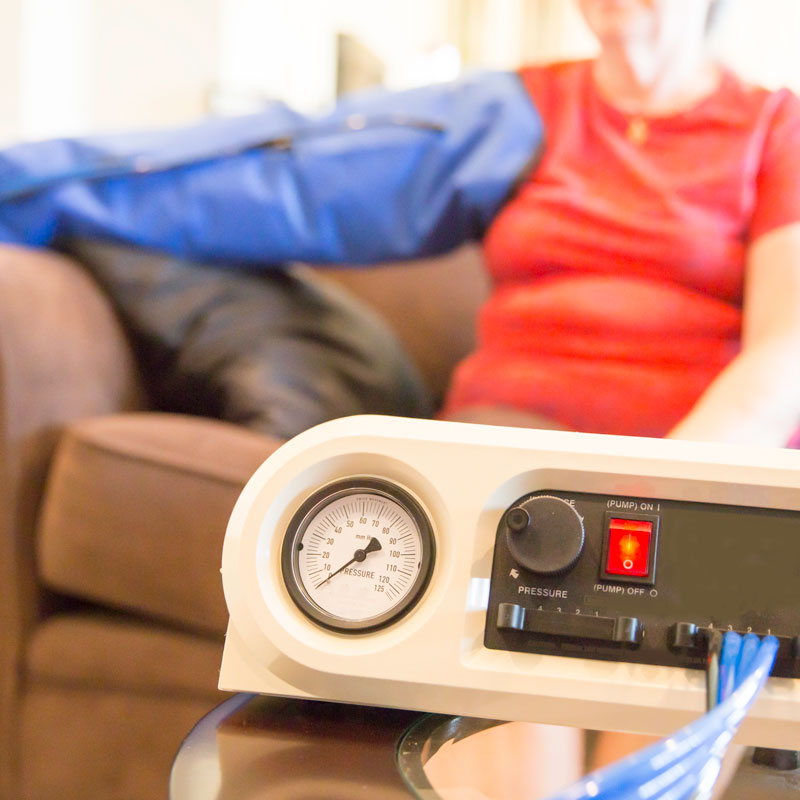Lymphedema
We Offer Lymphedema Evaluation & Treatment
Arizona Vein & Laser Institute provides lymphedema treatment to patients throughout Phoenix, AZ and the surrounding areas, including Glendale, Chandler, Surprise, Avondale, and Scottsdale. Though there is no cure for lymphedema, various treatments and therapeutic options can significantly reduce the swelling and pain caused by the internal condition. We offer a comprehensive array of lymphedema treatment options for our patients. Read below to learn more about lymphedema and our treatment options, and contact our office to schedule an appointment with our medical professionals today!
What is Lymphedema?
Lymphedema is an internal condition caused by damaged or removed lymph nodes. These damaged or nonexistent nodes stop the lymphatic system from properly draining, resulting in built-up lymph fluid and swollen limbs. The swelling can also occur in the face, neck, trunk, abdomen, or genitals.

The Causes of Lymphedema
Damaged or removed lymph nodes cause lymphedema. Oftentimes, this can be due to cancer treatments, though symptoms may not appear until years after treatment is over. Certain cancer treatments will remove or damage the body’s lymph nodes and result in lymphedema. Lymphedema causes include, but are not limited to, the following:
- Breast cancer surgery
- Pelvic surgery
- Radiation therapy
- Trauma
- Obesity
- Infection
- Tumors
- Heart conditions
- Kidney disease
- Lack of physical activity
- Blood vessel issues
The Symptoms of Lymphedema
Symptoms of lymphedema can vary from person to person. Severe cases of lymphedema can affect the ability to move the affected limb, increase the risks of skin infections and sepsis, and lead to skin changes and breakdown. Lymphedema symptoms include, but are not limited to, the following:
- Swelling in any part of the arm or leg, including toes and fingers
- A general feeling of tightness or heaviness
- Aching, discomfort, and a restricted range of motion
- Recurring infections
- Fibrosis (thickening and hardening of the skin)
We Offer Professional Lymphedema Treatment
Though there is no cure for lymphedema, there are several treatment options that can help mitigate symptoms, including swelling and pain. Arizona Vein & Laser Institute proudly offers a host of cutting-edge lymphedema treatment and therapy procedures. On rare occasions, surgery may be required to remove swollen tissue or to create new drainage routes. The treatments we offer include the following:
- Comprehensive physical therapy and decongestive therapy programs
- Specially-designed arm and leg wraps that facilitate lymph fluid back into the body’s core
- Compression garments for exercise
- Massage therapy using a specific technique known as manual lymph drainage
Lymphedema Treatment in Arizona
Arizona Vein & Laser Institute is the leading destination for comprehensive lymphedema treatment and compassionate care. While there is no cure for lymphedema, our specialists strive to control and reduce lymphedema symptoms to help patients reclaim a heightened quality of life. We provide treatment for lymphedema to patients in Phoenix, Arizona, and the surrounding areas.
Lymphedema is an internal condition caused by damaged or removed lymph nodes due to subsequent medical issues, trauma, or weight problems. These compromised or nonexistent nodes prevent the lymphatic system from draining properly, resulting in excess lymph fluid and swollen limbs. The swelling can also occur in the face, neck, trunk, abdomen, and/or genitals.
If you suspect you may be dealing with lymphedema, you must schedule an evaluation with a physician. A physician will conduct a physical assessment and review your symptoms, lifestyle, and medical history. You may also be referred for additional tests that enable your physician to visualize your lymphatic system before making an official diagnosis.
The lymphatic system consists of valves and pipes. Lymphatic fluid manages the cells in the body, collecting bacteria and harmful cells and transporting them through the system to the nodes. The nodes determine whether white blood cells should be sent to fight off damaging bacteria or cells or whether the lymphatic fluid can continue circulating.
The lymphatic system is an immune system function. Lymphatic fluid plays an integral role in triggering the mobilization of infection-fighting white blood cells when harmful bacteria or cells are detected. As such, damaged or nonexistent lymph nodes equate to a compromised inner surveillance system, making a person more susceptible to infection and illness.
Lymphedema is divided into two categories: primary and secondary. Primary lymphedema is considered a hereditary or genetic malformation or malfunction of the lymphatic system. Secondary lymphedema is trauma-induced, caused by accidents, injury, surgery, medical treatment, such as breast cancer treatment, or weight problems, including obesity.
Primary lymphedema cannot be prevented as it’s tied to genetics. Secondary lymphedema is caused by trauma and is often associated with subsequent medical procedures. To mitigate the risk of lymphedema, many surgical oncologists are conducting fewer lymph node dissections and solely removing sentinel nodes to deter its development. However, there is no proven method to prevent lymphedema entirely.
Lymphedema symptoms vary. Depending on the severity of the condition, the symptoms range from minor and virtually undetectable to life-altering. Lymphedema symptoms include but are not limited to:
- Swelling in any part of the limbs
- General tight or heavy sensation
- Discomfort, aching, and restricted range of motion
- Recurring infections
- Thickening/hardening of the skin (fibrosis)
When lymphedema symptoms are detected and addressed in the early stages, patients may be able to successfully resolve them. However, without early intervention, lymphedema is progressive. For the majority of patients, lymphedema symptoms cannot be fully eradicated, resulting in a sustained diagnosis that requires continuous medical support.
Breast cancer survivors who have undergone axillary lymph node dissection used to be at 50% risk of developing lymphedema. However, that number has progressively decreased. The risk of lymphedema development has lowered to approximately 15-25% and only 6% when surgery relies solely on sentinel node techniques without radiation.

Contact Us Today for Lymphedema Treatment
Arizona Vein & Laser Institute offers top-of-the-line treatment for lymphedema to patients throughout Arizona. Contact us today to learn more about our lymphedema treatment procedures or to schedule an appointment with our medical professionals. We look forward to providing you with the best possible treatment and care.
